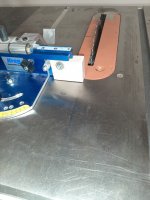Michael Kellough said:
Birdhunter said:
The thing that got me was I had the blade tilted to 45 degrees.
An argument for right tilt arbor?
You know, I've always wondered by people insist on ripping to the right and crosscutting on the left. Can someone explain it to me?
I'm right handed with a right-tilting arbor tablesaw. I both rip and cross-cut on the left hand side, and have done so since the late 1980s. What am I missing?
A) You don't want to cut pieces with the blade tilted towards your work piece, for a few reasons: 1) the workpiece can get trapped between the blade and table, leading to kickback. 2) you don't want the blade tilting towards the piece you're holding. 3) you can cut into your rip fence or miter gauge fence (this thread).
B) You want to have as much table support for your workpiece as possible for both wide rips and long cross-cuts. Doing both on the same side of the blade means you only have to build out table extensions in one direction.
C) Doing both on the same side requires less space in your shop, see above about building out on one side.
The only time I can see doing rips on the right and crosscuts on the left is if you have a true sliding table tablesaw.

